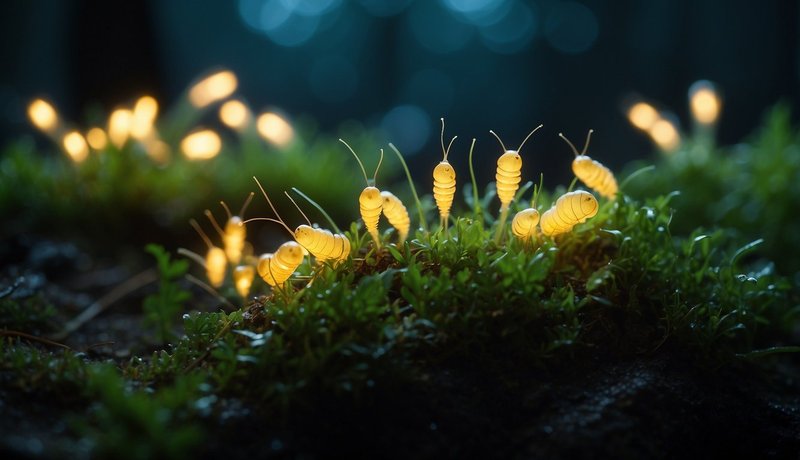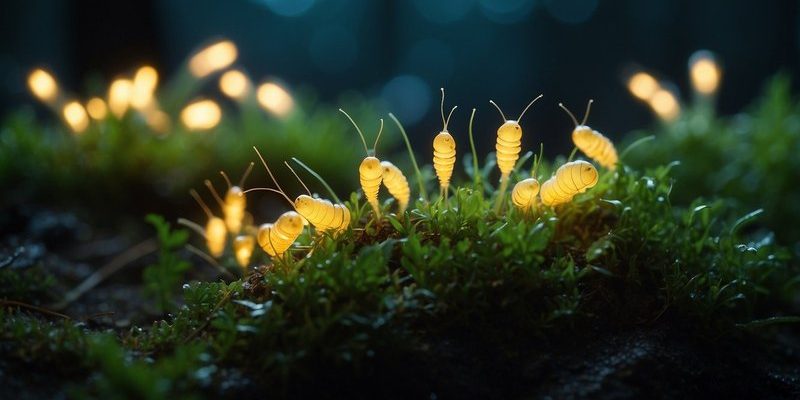
So, let’s dive in and explore this captivating partnership. Imagine you’re wandering through a lush forest, observing the way the light filters through the trees. Below your feet lies a whole world—home to glow worms and a critical source of nutrients. **Understanding how these creatures interact with their habitat** helps paint a clearer picture of their ecological role and the importance of preserving these natural spaces.
What Are Glow Worms?
Glow worms, primarily found in places like New Zealand, Australia, and some parts of Europe, are fascinating insect larvae that use bioluminescence to attract prey. While most of us picture glow worms as those magical, glowing creatures, it’s essential to understand that they’re actually the larvae of various fly species. Here’s the thing: these little guys light up to lure unsuspecting insects into their sticky silk threads, which they use for trapping.
You might be wondering why they glow. The bright blue-green light comes from biochemical reactions in their bodies. It’s almost like nature’s flashlight! This glow is not just for show; it’s a survival mechanism. It helps increase their chances of catching dinner in the dark. Interestingly, while they might seem like lone stars in the sky, they thrive in a network of interactions within their habitat.
The Importance of Leaf Litter
Leaf litter plays a vital role in a forest ecosystem, acting like a cozy blanket for the soil beneath. This layer consists of fallen leaves, bark, and other organic materials that create a rich environment for many organisms. It’s **not just trash**; it’s a treasure trove! Leaf litter serves as a habitat for numerous insects, fungi, and microorganisms, all of which contribute to the nutrient cycling in the ecosystem.
But how does this relate to glow worms? Well, leaf litter offers them crucial benefits. It provides **shelter**, helping them hide from predators and harsh weather conditions. Plus, the organic matter is a source of food. As leaves break down, they release nutrients into the soil, fostering a healthy environment for the glow worms and their prey. Think of leaf litter as a buffet, where glow worms dine on tiny insects attracted to the decaying matter.
How Glow Worms Utilize Leaf Litter
Glow worms have a specific strategy when it comes to using leaf litter to their advantage. They usually set up their silk threads among the decaying leaves, where they can blend in effectively. This tactic not only protects them but also maximizes their chances of catching food. Their silk is designed to trap flying insects that venture too close, making leaf litter an ideal hunting ground.
The decomposition of leaf litter also encourages a diverse ecosystem. As leaves break down, they promote the growth of fungi and bacteria, attracting various insects—dinner options for the glow worms. When decomposition happens, it creates a cycle of life. The more insects, the more food for the glow worms, and the cycle continues. It’s a win-win for everyone involved, showing just how interconnected this habitat can be.
Effects of Environmental Changes on Leaf Litter and Glow Worms
Unfortunately, changes in the environment, like deforestation or pollution, can dramatically affect the relationship between glow worms and leaf litter. If trees are removed, the supply of new leaves diminishes, which can lead to a decline in leaf litter. Less leaf litter means fewer nutrients in the soil, leading to a decrease in the number of insects thriving in that area. Without their food source, glow worm populations can dwindle as a result.
Additionally, pollution can harm the quality of leaf litter. Chemicals can disrupt the decomposition process and affect the organisms living in the soil, causing a ripple effect throughout the ecosystem. Protecting forests and minimizing pollution is essential for maintaining the habitats that support glow worms and countless other species.
Preservation of Glow Worm Habitats
Protecting the habitats of glow worms and the crucial leaf litter environment requires thoughtful action. Here are some ways to help maintain their homes:
- Support conservation efforts: Engage with local organizations working to protect natural habitats.
- Plant native vegetation: Encourage local biodiversity by planting native plants that contribute to leaf litter.
- Educate others: Share knowledge about the importance of glow worms and their habitats to inspire others to care.
- Practice eco-friendly habits: Reduce waste, limit chemical use, and promote recycling to minimize pollution.
Preserving these delicate ecosystems ensures that future generations can also witness the enchanting glow of these little larvae. It’s about keeping the lights on in the world of natural wonders.
The Fascinating Life Cycle of Glow Worms
Glow worms go through a fascinating life cycle that further emphasizes their reliance on leaf litter. They start as eggs laid by adult females in moist, sheltered areas. After a few weeks, the larvae emerge and begin their journey into the world. For about six to twelve months, they will feed on insects while developing their glowing silk nets among the leaf litter.
After this feeding phase, glow worms undergo metamorphosis, entering a pupal stage. Here, they utilize the protection provided by the leaf litter as they transition into adulthood. The entire life cycle illustrates their dependence on healthy, thriving habitats. Without leaf litter, they wouldn’t have the resources needed to grow, thrive, and reproduce.
In the grand scheme of nature, glow worms and leaf litter share a beautiful relationship that is essential for their survival. This interaction highlights the intricate balance that exists within ecosystems. As we learn more about these little wonders and their habitats, we come to appreciate the importance of **protecting our natural environments**.
So the next time you find yourself under a starlit sky, remember there’s a world below your feet—an inspiring example of nature’s resilience and beauty. By understanding and nurturing the relationship between glow worms and leaf litter, we can help preserve the enchanting wonders of our planet for years to come.

